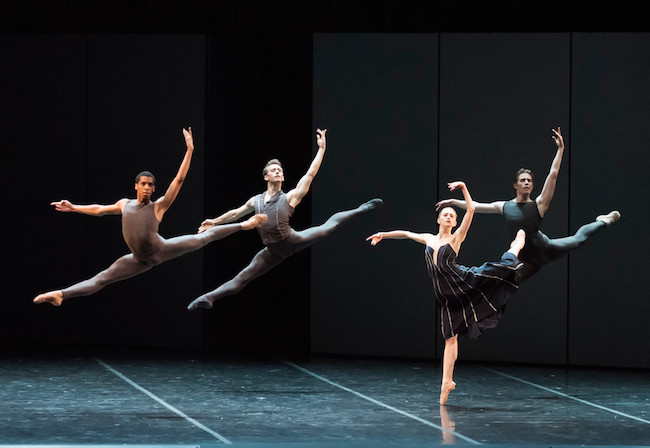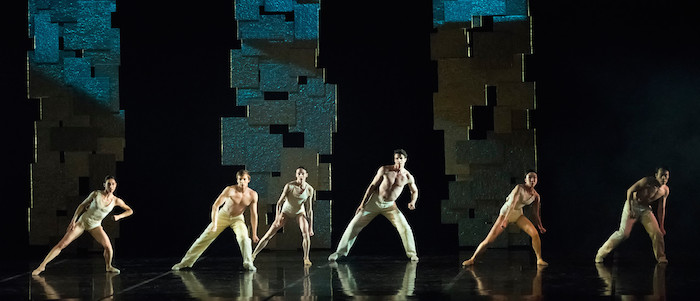Fuse Dance Review: Four Flavors — “Mirrors” at Boston Ballet
What interested me about Bitches Brew was the chance to discover how choreographer Karole Armitage re-rigs classical ballet steps.
Mirrors, performed by the Boston Ballet. Boston Opera House, Boston, MA, through May 28.

Misa Kuranaga and Irlan Silva in Karole Armitage’s “Bitches Brew.” Photo: Gene Schiavone, courtesy Boston Ballet.
By Marcia B. Siegel
Contemporary dance can embrace any number of forms and fusions. Four of them are featured in “Mirrors,” Boston Ballet’s last program of the season, which began Friday and runs through May in alternation with Swan Lake.
First on the program is José Martinez’s Resonance, made for the company two years ago. The piece is descended from a period of European dance when the availability of generous funding enabled international ballet stages to offer large-scale spectacle for modern tastes. Resonance struck me as a surfeit of riches that overcame a surfeit of dancing.
The dance was accompanied by Franz Liszt’s Transcendental Etudes, played by not one but two pianos, one onstage (the pianist was Freda Locker) and one in the orchestra pit (Alex Foaksman). There were movable sets — giant white panels that slid back and forth, hiding and revealing dancers — and a busy lighting design that ranged from expressionistic shadows to pinpoint spots. (Sets and costumes are by Jean-Marc Puissant, lighting by John Cuff.) The female dancers changed costumes from tanksuit leotards to quasi-strapless Fortuny dresses. Or at least some of the women did.
While I was trying to absorb the hair-flinging music Friday night, the dancers kept appearing and reappearing in changing combinations. The movement, quite classical with some modernistic displacements, went its own way, seemingly oblivious to or perhaps defeated by Liszt’s distraught pianism.

Lawrence Rines, Patrick Yocum, Dusty Button, and Bo Busby of Boston Ballet in José Martinez’s “Resonance.” Photo: Gene Schiavone, courtesy Boston Ballet.
Somewhere near the end, Lia Cirio, who’d exchanged her dress for a leotard, danced with Lasha Khozashvili, slowly stretching and yearning. They both were serious and engaged with each other and with the movement. I thought this pas de deux could have been a stand-alone ballet. It was more moving than the many on-again, off-again appearances of the other principals, Dusty Button and Patrick Yocum, and the 16 men and women in the corps de ballet.
Cirio impressed me again, stretching and yearning with Eris Nezha to an old-fashioned electronic score by Syrinx, in Belong (1973), by the late Canadian choreographer Norbert Vezak. The movement for this combined pointe work with acrobatics. Vezak worked during a time when ballet dancing gave up its elitist postures and frankly celebrated dance as sublimated sex. Belong began and ended on the floor, encouraging the audience to see the whole dance as an artistic metaphor for what couples do in bed.
I couldn’t make much sense out of the new Smoke and Mirrors by retired principal dancer Yuri Yanowsky. Set to a loud, post-minimalist recorded score by Lucas Vidal, the dance gave prominent parts to four principal couples and three secondary couples. It was as if Yanowsky intended to show off his former co-workers, and he earned a standing ovation for it.
The ensemble were dressed in white trousers and bare chests for the men and unitards for the women, with white corset-like garments bound around their mid-sections. (Costumes were by Charles Heightchew.) The women wore soft shoes. The ballet-cum-modern movement emphasized the arms, and all the dancers looked anxious. Maybe they were oppressed by the three totem-size set pieces looming behind them (by Benjamin J. Phillips) or the whispering but unintelligible voices sewn into the music. Or maybe the smoke.

Boston Ballet in Yury Yanowsky’s “Smoke and Mirrors.” Photo: Gene Schiavone, courtesy Boston Ballet.
Last on the evening was the premiere of Karole Armitage’s Bitches Brew, to excerpts from the eponymous modern jazz album by Miles Davis. A fascinating score that dates back to the 1970s with electronic effects, eccentric orchestrations, and unexpected rhythms, it still sounds modern.
The dance begins with a long solo by a woman in a black metallic unitard with very long, loose black hair (Ji Young Chae). She’s soon joined by a group of others, also wearing metallic lycra, with brightly colored knee-hi’s over their black tights. Women wear their hair short and straight, with long wisps, dyed red or orange, flapping over their eyes. The cast of characters keeps changing; duets ensue between the other principals (Dusty Button, Ashley Ellis, Misa Kuranaga, Khozashvili, Yocum, and Irlan Silva), and an ensemble of seven other women.
Armitage puts the women on pointe, and then foils any expectation that they’ll behave like classical ballet dancers. Armitage acquired the honorific “punk ballerina” years ago and has outgrown it by now, but the publicity blurbs still use it. What interested me about the dance was the chance to discover how Armitage re-rigs classical ballet steps.
On pointe, the women curve their upper torsos forward, tilt off center; they get promenaded on half-toe by their partners. Armitage uses the plié to put a jazzy bounce in the step, but the dance, like the music, resists conventional jazz. The step lexicon includes slides, backward sprints, and changes of direction while poised on pointe.
The dance has no sets, but the dramatic lighting (by Clifton Taylor) and the silvery unitards (Peter Speliopoulos) reinforced Armitage’s active visual palette. The smoke effects were anti-climactic after Yanowsky’s ballet.
Internationally known writer, lecturer, and teacher Marcia B. Siegel covered dance for 16 years at The Boston Phoenix. She is a contributing editor for The Hudson Review. The fourth collection of Siegel’s reviews and essays, Mirrors and Scrims—The Life and Afterlife of Ballet, won the 2010 Selma Jeanne Cohen prize from the American Society for Aesthetics. Her other books include studies of Twyla Tharp, Doris Humphrey, and American choreography. From 1983 to 1996, Siegel was a member of the resident faculty of the Department of Performance Studies, Tisch School of the Arts, New York University.
Tagged: Belong, Bitches Brew, Boston-Ballet, José Martinez, Karole-Armitage, Marcia B. Siegel, Mirrors, Norbert Vezak, Resonance, Smoke and Mirrors
